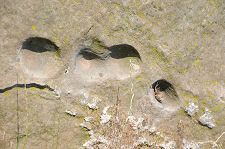 The Twelve Apostles Stone Circle from the South-East |
The good news is that the largest stone circle to be found anywhere in mainland Scotland stands in an easily accessible location less than two miles north-west of the A75 Dumfries bypass. The less good news is that when you arrive your first reaction is probably going to be the same as ours: "Is this it?"
Anyone who has visited many stone circles will tell you that they tend to have a certain something about them, a sense of antiquity, a sense of place, a sense of somehow being special and different. Perhaps the most disappointing thing about the Twelve Apostles is that it lacks any discernible atmosphere. Last time we visited the Ring of Brodgar stone circle on Orkney we encountered someone who was there, he said, to await a visit by aliens. We very much doubt that anyone's ever propped themselves against one of the Twelve Apostles in the evening to await... well, anything much at all. Having said that, since we originally wrote those words, one visitor has been in touch to say she finds it a friendly and welcoming place: perhaps it will work better for you than it did for us.
What is beyond doubt is that there are a number of things about the Twelve Apostles that do make it an intriguing site, a place that leads you to ask questions about its origins and purpose. It is certainly a place worth visiting, if only to allow you to make your own mind up about it.
Access to the circle can be gained via a stile from the minor road to the south-west; though judging from the tracks in the grass the more common way in is from the gate near the B729 junction a couple of hundred yards to the north-west of the circle.
The Twelve Apostles is a circle of, arguably, eleven stones, measuring some 86 metres in diameter. It is not set out in a true circle, being slightly "squashed" on one side. It is thought that there were probably 18 stones in the circle originally, and that some of those now found lying down were originally standing erect. The circle was first recorded in 1882, when a bronze figure thought to represent St Norbert and thought to date back to the 1100s was dug up during an excavation. The figure now resides in Dumfries Museum.
The stones themselves are a mix of sizes and types. The standing stones measure up to around 2m in height, but the largest are now lying down. Various visitors have noted "cup marks" on a number of the stones. Some of these do actually look like cup marks resulting from the activities of our ancient ancestors, while others are thought to be an effect of weathering.
Perhaps the oddest markings are those on one stone that for all the world appears to describe the shape of an arrow. More easily explained is the apparent presence of a line of different coloured vegetation cutting across the circle between two stones. A visitor in 1912 noted the circle was in two fields separated by a hedge. It is presumably the traces of the hedge that can be seen on the ground today.
 Five(?) of the Apostles |

|
|
|
Visitor InformationView Location on MapGrid Ref: NX 947 794 What3Words Location: ///picked.drop.political |
 One of the Larger Stones |
 ...and Another One |



